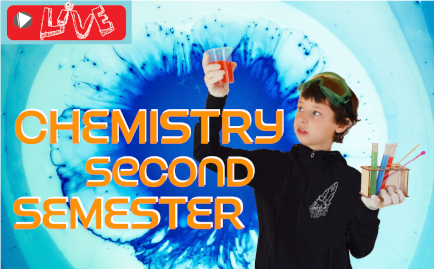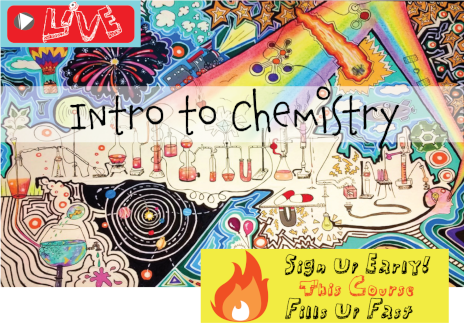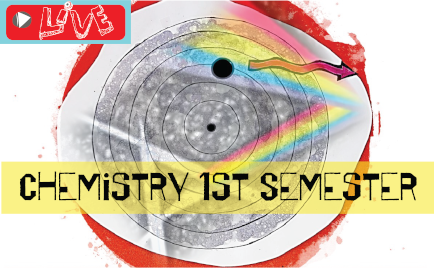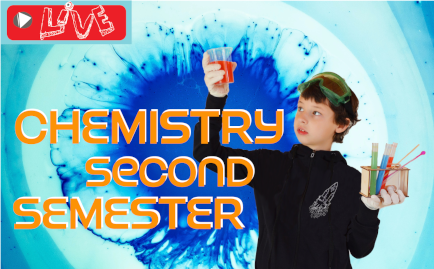High School Chemistry Experiments and Lab Course

Our High School Chemistry Experiments and Lab Course features simulated data, so you can safely complete your chem lab experiments at home!
Live Online High School Chemistry Experiments and Lab Course Overview
Our High School Chemistry Experiments and Lab Course covers the topics found in the second half of a normal high school chemistry textbook. It’s a continuation course following First Semester Chemistry.
You’ll see and perform a variety of laboratory activities to reinforce the concepts hands-on. Most of the advanced math, technical jargon, complicated chemicals, and fancy lab equipment have been removed from the topics so you can truly master the chemistry concepts.
We’ll spend about half the course understanding acid-base-water chemistry conceptually, in addition to making pH predictions. You’ll learn how the whole world is in equilibrium, why matter flows, the conditions under which chemical reactions occur (or not), how to generate electricity, and the relation of all these concepts to this invisible stuff called energy.
High School Chemistry Experiments and Lab Course Topics
Each lesson of our High School Chemistry Experiments and Lab Course has an experiment demonstrating the chemistry principles covered in that lesson.
Lesson 1: pH and 1-into-10 Dilutions
We learn about pH and dilutions.
Lesson 2: Dilution Factors, ICE Tables and % Acid Dissociation
We learn about dilutions factors, ICE tables, and percent dissociation for acids.
Lesson 3: Strong acids, weak acids and pKa
We learn about strong and weak acids and tabulated pKa tables.
Lesson 4: Strong bases, proton acceptors, neutral salts
We learn about strong and weak bases as proton acceptors (Broenstead-Lowry bases). We learn about salts being either neutral or basic.
Lesson 5: Conjugate acid-base pairs, pKb and pOH
We learn about conjugate acid and conjugate bases that exist as conjugate pairs. We focus on writing proton acceptor and proton donor reactions. We discuss pKb and pOH for bases, much like pKa and pH for acids.
Lesson 6: Neutralization Reactions & Titration Curves
We learn about titration curves, plotting the pH as an acid-base reaction proceeds past the endpoint of titration.
Lesson 7: Buffers and Shifting Equilibria
We learn about making buffer calculations and preparing buffers. We learn about shifting equilibria and the Le Chatelier principle
Lesson 8: Vapor-Liquid Equilibrium
We shift topics to learn about the equilibrium that exists between a liquid and the vapor over it’s surface, an extremely common situation on Earth. We learn to read steam tables and vapor pressure data.
Lesson 9: Measuring Pressure
We learn about pressure conceptually and scientifically.
Lesson 10: Experiment to Measure the Gas Constant R
We do an all time classic experiment to collect gas over water, correcting for the vapor pressure of water. We calculate the Gas Constant R from experimental data from a simple kitchen setup.
Lesson 11: Analyzing Gasses
We learn more about the gas laws, the Joule-Thompson cooling effect, and the design of internal combustion engines using PV diagrams.
Lesson 12: Filtration and Thermal Degradation
We consider thermal degradation with oxygen (combustion) and without oxygen (pyrolysis). We discus the products, including charcoal, or pure carbon. We perform an experiment to use activated carbon as a filtration medium to separate contamination from water.
Lesson 13: Kinetics & The Iodine Clock Reaction
We do the iodine clock reaction, a true dazzler in the world of chemistry. We’ll do a simple and safe kitchen version, and we’ll get introduced to rates and chemical kinetics.
Lesson 14: Kinetics and Equilibrium
We will see the theoretical connection between equilibrium and rates for chemical kinetics. It’s a major, over-arching theory that connects many of the big ideas in chemistry. We’ll make reaction diagrams showing the activation energy and enthalpy or heat of reaction.
Lesson 15: Electrochemistry
We get an introduction to electrochemistry, and we build a battery (voltaic cell or also called a Galvanic cell) using a fruit or vegetable such as a potato.
The Chem Lab Course Teacher
Hi, I’m Dr. Scott, the course creator and teacher. I created a set of videos of experiments so we can analyze online chemistry experiments safely at home or anywhere. Unlike other chemistry courses, there will be experiments that demonstrate the concepts covered in each lesson. Note that your typical chemistry course has a bunch of random experiments that aren’t connected to the textbook lessons. I made this course to overcome that traditional mismatch between chemistry lessons and chemistry experiments. Why? Because the traditional way is confusing to learners, and it’s a lot more work for teachers. I prefer we learn chemistry the easy way, in which the experiments and lessons are logically and directly connected. You won’t find that elsewhere!
I’m a former college chemistry professor, and I’ve built lots of labs the right way. Which means we focus on safety and correct lab protocols in the course. That way, you’ll be prepared for the real world. Lab safety is a big issue out there, and you’re expected to know this stuff if you ever go to a college lab or work in a lab some day. I’m working with two nonprofits, the Laboratory Safety Institute and also Beyond Benign, to focus on lab safety and safer chemistry.

Our Multi-Year Sequence of Chemistry Courses
Lab science classes in general require lots of background knowledge. There are other chemistry courses that should be taken first to prepare you for this online chem lab course.
A class called First Semester Chemistry is normally taken before this online chem lab course, called Second Semester Chemistry. If you need more science background, we also have a beginner course called Intro to Chemistry.
Course Details for the High School Chemistry Experiments and Lab Course
Live Classes: Yes.
Videos Included: The video textbook has 250 videos (35 hours total) including complete chemistry lessons, detailed worksheet solutions, 25+ experiments, and instructions for reporting laboratory data.
Materials Included: The course has 45 printable pdf files including worksheets, answer keys, and class notes.
Time commitment: Learners typically spend 3-7 hours per week, which includes combined live in-class time and out-of-class time.
Course duration: Semester length (half school year) or summer session.
Teacher Support Included: Dr. Scott teaches the live High School Chemistry Experiments and Lab Course personally. He is available for questions and evaluates worksheets by email. There are grades and a certificate of completion at the end.
Learning Outcomes for the Online Experiments and Lab Course
Learners completing our High School Chemistry Experiments and Lab Course will be able to:
Master acid-base chemistry.
Use and calculate pH.
Master equilibrium.
Understand chemical kinetics and rates.
Understand electrochemistry basics.
Explain reduction and oxidation in the real world.
Record and report experimental data.
Build and analyze experiments safely.
Apply chemistry to real world problems.
Confidently approach science.
Is This The Right Course for Me?
This High School Chemistry Experiments and Lab Course is ideal for:
– college students struggling with General Chemistry II


